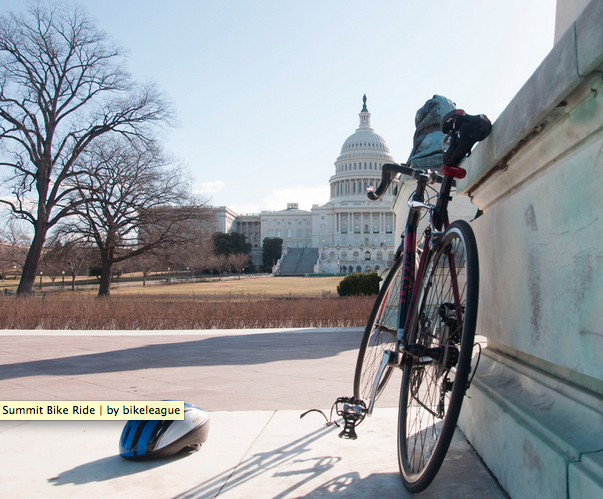DISCOVER YOUR LOCAL BICYCLING COMMUNITY
Find local advocacy groups, bike shops, instructors, clubs, classes and more!
Analysis: DRIVE Act
 As is evident in the acronym, The Developing a Reliable and Innovative Vision for the Economy Act, or DRIVE Act, is not focused on improving multi-modal transportation but rather on the interstate and highway system. The U.S. Senate introduced its version of the new transportation bill this week and it is set for a hearing on Wednesday.
As is evident in the acronym, The Developing a Reliable and Innovative Vision for the Economy Act, or DRIVE Act, is not focused on improving multi-modal transportation but rather on the interstate and highway system. The U.S. Senate introduced its version of the new transportation bill this week and it is set for a hearing on Wednesday.
While we were successful in getting some small changes to the Transportation Alternative Program (TAP), we do not see any real innovation or vision to really grapple with transportation needs of this 21st Century.
I’ve included the details on what we were able to include on TAP, but let’s take a moment to talk about the bill overall.
- DRIVE includes an increase in funding overall, including a freight program. However, the funding levels suggested in the bill are just that — suggestions. There’s no funding source for the increase.
- DRIVE de-emphasizes safety. The bill actually decreases the percentage of funding that goes to safety.
- DRIVE strikes a provision in the Highway Safety Program that allows funding to go to safety education and awareness of traffic laws. There are other places that do fund such programs, but this follows the exclusion of biking and walking safety program funding from TAP in MAP-21, the current transportation law, so limits funding available.
There are a few good things, too. It adds an electric car corridor section, includes eligibility of Intelligent Transportation Systems, and a mention of the NACTO guide in the design standards, etc. But the big takeaway is this bill is not a coherent vision of the future, or even of the present.
Now, let’s take a look at changes to TAP in this proposed bill.
TAP Funding Overall
- Currently: MAP-21 cut funding levels by 30 percent, by making TAP 2% of all other programs. In 2014, TAP was funded at $819 million down from $1.2 Billion in 2011.
- League Suggestion: TAPIA increased funding levels from 2% to 3% which would have restored funding close to the 2011 level.
- DRIVE Act: Increases funding to $850 million a year. However, the funding is no longer connected to other programs so will not increase along with other parts of the bill.
- Analysis: This would stop TAP funding from increasing even as other programs increase.
Local Control over Spending
- Currently: 50% of TAP funds go to a state run grant program, and 50% are distributed to communities based on population. Especially in small communities and rural areas, this means funding is often too small for more than one project.
- League Position: Two-thirds of the funding is distributed by population, which ensures a fairer distribution of funding among communities of all sizes.
- DRIVE Act:100% of the funds are distributed by population, but the state can transfer 50% of that funding at any time.
- Analysis: This makes it hard for the Metropolitan Planning Organizations (MPO) to plan if they are concerned the states can take away the money at any time.
Who can Apply
- Currently: Non-profits and small Metropolitan Planning Organizations are ineligible to receive TAP funds. States have no flexibility to contract with qualified non-profits to run Safe Routes to School education programs; small MPOs can’t complete their bikeway networks.
- League Position: Make non-profits and small MPOs eligible recipients of TAP funds.
- DRIVE Act: Adds NGOs as eligible recipients.
- Analysis: This will help NGOs that get state contracts for bike share and Safe Routes to SChool Program. This, however, does not help small MPOs.
Create an Even Playing Field
- Currently: MAP-21 subjected TAP projects to the same rules and regulations as large highway projects, posing additional challenges and higher costs for communities. This provision was inequitably applied only to TAP funds and for similar projects built under other highway funding programs.
- League Position: Remove the burdensome requirements for smaller projects, like biking and walking infrastructure.
- DRIVE Act: It requires U.S. Department of Transportation to develop guidance to expedite small, low-impact projects.
- Analysis: This is a positive development.
Flexibility for rural and underserved communities
- Currently: TAP requires each individual project meet a strict 20% local match (federal funds cover the remaining 80%). Some communities are unable to raise that local match.
- League Position: Give flexibility to states and MPOs to meet the 80/20 match by bundling projects together.
- DRIVE Act: Each project must include a 20% match.
- Analysis: This give no relief to low income or rural communities that have a tough time making the match.
Provide Certainty for Recreational Trails Program
- Currently: Governors have the ability to opt out of the Recreational Trails program each year. This makes it hard to plan for upcoming trails
- League Position: Remove the ‘opt out’ language so Recreational Trails funding is automatic
- DRIVE Act: The bill does not change anything regarding the Recreational Trails Program
- Analysis: Advocates will have to continue being a watch dog to ensure Governors do not opt out.
Stay tuned for more as Congress continues to work toward a final transportation solution. Be sure to sign up for our action system, too, as we unite the voices of bicyclists across the country.